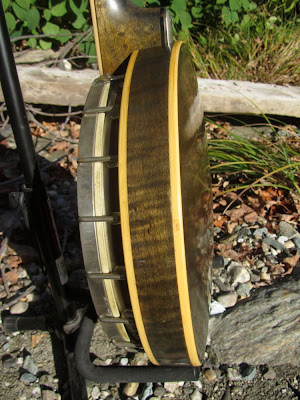c.1924 Weymann Style 150 Tenor Banjo
What a beaut this old Weymann is! Serial dates it to 1924, it has oodles of flamed and curly maple throughout its build, and it's also the more unusual and fun greenish-grey-brown finish type that lets it stand out from the pack so easily. Add to that yellowy-cream binding and pretty touches of pearl inlay and you've got a classy rig.
For reference: Weymann banjos were made in Philadelphia and while they're not as well known today as Gibsons, Langes (Paramount/Orpheum), Bacons, and Vegas... they're really exceptionally well-built instruments and if one browses professional band photos from the time you'll notice a repeating pattern of Weymann use on display.
This particular model 150 has a "medium scale" of 22" which makes sense for its time, that being the transition period from mostly short-scale 20-21" 17-fret tenor models to the longer-scale 23" 19-fret models. I actually like the 22" scale a lot because it feels like the best of both worlds: you can use lighter gauges to tune to the same pitch and you also get them slightly slinkier than on a 23" scale instrument.
This banjo is almost entirely original, save 1 hook & nut, the newer bridge, and a replacement set of tuners at the headstock. It even has its nice "press on" resonator which often seems to get separated from the parent banjo over time.
Pretty pearl inlay in the headstock. Original bone nut.
Bound ebony board and pearl dots.
Someone must have been stringing this banjo pretty heavily because there was a bit of relief (hair over 1/64") in the neck when this came in. Weymanns are typically heavily-built so the gauges must have been something awful to do anything like that.
I managed to reduce it to essentially dead straight by leveling the frets along a straight line and thus removing material at the first position frets and way high up the neck. They've still got life left, but the big benefit is that it plays perfectly up the neck with good, low, 1/16" action at the 12th fret.
Other work included cleaning and general setup.
This adjustable Weymann-patent tailpiece is delicious and well-made. The engraved coverplate removes to install strings and the typical screw-down adjuster lets you control downpressure behind the bridge. As well as changing tone, this can also let you slightly adjust action height on the fly in a pinch (more downpressure = lower action, brighter tone -- less = higher action, warmer tone).
See all that beautiful flamed maple? The faded dark walnut stain looks really cool on it, too.
Pretty stuff!
Here's that new set of geared, planetary banjo pegs that were installed probably fairly recently. They've got pearl buttons on them and work very well, with smooth 4:1 tuning.
The resonator back (which is laminate for strength) shows some big scuff marks. I would normally remove these but didn't want to dig into the finish too much to do so since they weren't coming up easily.
Nice, curly-maple 2-piece (with center strip) neck.
Back of the headstock with fun Weymann decal.
Here's the back of the rim with the slip-on/off resonator removed. I love the multi-ply purfling inset into the rim's bottom edge. The big long bar that goes from the heel to the dowel is a neck-angle reinforcement mechanism that, in addition to the normal ebony-shim neck brace seen under it, helps keep the neck rigid to the pot and tight at the bottom of the heel. This type is a Weymann patent assembly.
Serial numbers and ebony neck-brace shims & brace itself.
Good, heavy-duty Weymann hardware (nickel-plated brass). See the "sleeve" that comes out under the lip of the skin head? This skirt goes to the top of the rim and then is curled over a hoop-style tonering, effectively making a "Vega Little Wonder" style tonering on this rim. Tonally, mated to this Weymann rim, this makes a loud, crisp, bright banjo with a lot of projection vs. a warmer, sweeter, but still precise tonality one finds on the lower-level wood-top Weymann rims.
Gotta love the flamed maple everywhere and those nice buttery-yellow accents.
Here's that resonator, removed. Those felted "feet" inside hold onto the rim of the banjo with friction, so it's really easy to remove the resonator to play a bit more quietly or with a mellower tone.
Almost forgot to mention the great hard case (original) and...
...the tutor's practice advice!

























Comments
I also ended up deciding that, unless the project instrument is really messed up or very unoriginal to begin with, that it's better to preserve than modify. Part of my do no harm mantra. :)